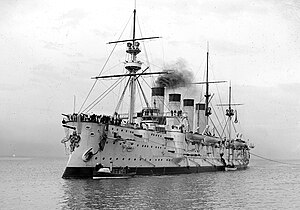 Gromoboi in 1901 visiting Australia
| |
| Class overview | |
|---|---|
| Name | Gromoboi |
| Operators | |
| Preceded by | Rossia |
| Succeeded by | Bayan class |
| Built | 1897–1900 |
| In commission | 1900–1922 |
| Completed | 1 |
| Scrapped | 1 |
| History | |
| Name | Gromoboi (Russian: Громобой) |
| Builder | Baltic Works, Saint Petersburg |
| Laid down | 14 June 1897[Note 1] |
| Launched | 8 May 1899 |
| Commissioned | November 1899 |
| Fate | Sold for scrap, 1 July 1922 |
| General characteristics | |
| Type | Armoured cruiser |
| Displacement | 12,455 long tons (12,655 t) |
| Length | 481 ft (146.6 m) |
| Beam | 68.6 ft (20.9 m) |
| Draught | 26 ft (7.9 m) |
| Installed power | 14,500 ihp (10,800 kW) |
| Propulsion | 3 shafts, 3 vertical triple expansion steam engines, 32 Belleville water-tube boilers |
| Speed | 19 knots (35 km/h; 22 mph) |
| Range | 8,100 nautical miles (15,000 km; 9,320 mi) at 10 knots (19 km/h; 12 mph) |
| Complement | 874 officers and crewmen |
| Armament |
|
| Armour |
|
Gromoboi (Russian: Громобой, meaning: "Thunderer") was an armoured cruiser built for the Imperial Russian Navy in the late 1890s. She was designed as a long-range commerce raider and served as such during the Russo-Japanese War of 1904–05. When the war broke out, she was based in Vladivostok and made several sorties in search of Japanese shipping in the conflict's early months without much success.
Gromoboi, with the other armoured cruisers of the Vladivostok Cruiser Squadron, attempted to rendezvous in the Strait of Tsushima with the main portion of the Russian Pacific Fleet sailing from Port Arthur in August 1904. The Fleet was delayed, and the squadron returned to port alone. On the return, the squadron encountered a Japanese squadron of four armoured cruisers blocking their passage to base. The Japanese sank the oldest Russian ship, Rurik, and damaged Gromoboi and Rossia during the subsequent Battle off Ulsan. Both Russian ships were repaired within two months. Gromoboi ran aground immediately after completing her repairs and was out of action for four months. Three months after the damage from the grounding incident was repaired, she struck a mine, but successfully returned to port. Her armament was reinforced while under repair, but she saw no further action during the war.
Gromoboi was transferred to the Russian Baltic Fleet after the end of the war and began a lengthy refit that was completed in 1911. She was mostly inactive during World War I, but had her armament and protection upgraded during the war. She was placed into reserve in 1918 and sold to a German company in 1922 for scrapping. She was forced aground near Liepāja during a storm en route to Germany and was scrapped in place.
Cite error: There are <ref group=Note> tags on this page, but the references will not show without a {{reflist|group=Note}} template (see the help page).